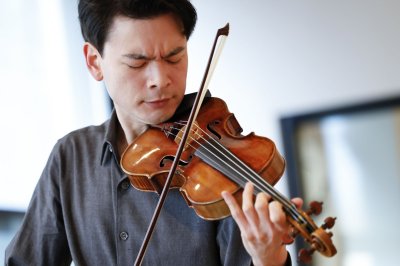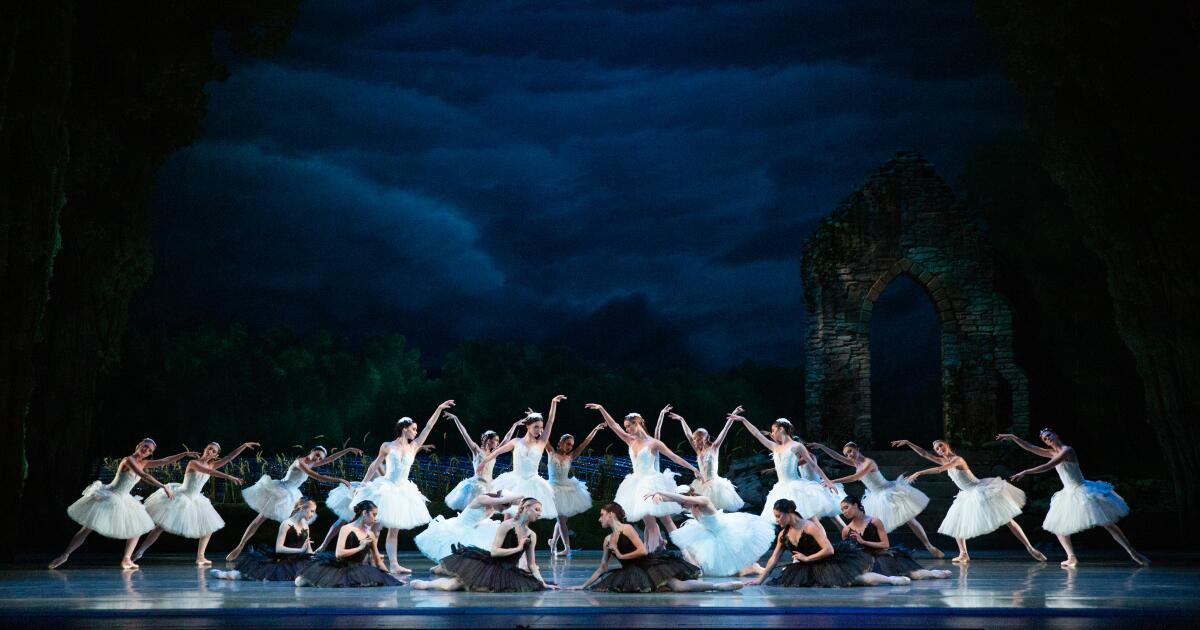Los Angeles is neither a dance center nor a dance desert. We don’t have much of a history of nourishing major ballet companies. We do have a plethora of smaller companies — modern, classical and international.
You may have to look for it, but somewhere someone is always dancing hereabouts for you.
I sampled three very different dance programs last weekend at three distinctive venues in three disparate cities and for three kinds of audiences. The range was enormous but the connections, illuminating.
At the grand end of the scale, Miami City Ballet brought its recent production of “Swan Lake” to Segerstrom Hall in Costa Mesa — beginning a run of varied versions of Tchaikovsky’s beloved ballet this summer. It will be Boston Ballet’s turn at the Music Center this weekend. San Francisco Ballet gets in the act too, dancing excerpts at the Hollywood Bowl as part of this year’s Los Angeles Philharmonic “Tchaikovsky Spectacular.”
On a Television City soundstage in the Fairfax district, American Contemporary Ballet, a quintessential L.A. dance company that explores unusual sites around town, is presenting George Balanchine’s modernist classic “Serenade,” along with a new work by the company’s founder, choreographer Lincoln Jones. Meanwhile, on Saturday night, violinist Vijay Gupta and dancer Yamini Kalluri mingled Bach and Indian Kuchipudi dance tradition at the 99-seat Sierra Madre Playhouse.
Miami City Ballet has attracted attention for mounting what is being called a historically informed “Swan Lake” by the noted Bolshoi-trained choreographer Alexei Ratmansky. He has done his best to re-create the 1895 production at the Mariinsky Theater in Ratmansky’s hometown of St. Petersburg.
Historically informed performance, or HIP, is a loaded term, and “Swan Lake” is a loaded ballet. HIP came about when the early music movement discovered that trying to re-create, say, the way a Handel opera might have sounded in the 18th century by using period instruments with what was believed to be period practice techniques proved deadly boring. Eventually, the movement realized that using the old instruments in sprightly, imaginative and contemporary ways instead made the music sound newly vital, and even more so when the staging was startlingly up to date.
Ratmansky’s reconstructed “Swan Lake” does much the opposite with modern instruments and old-fashioned ballet, and it got off to a disorienting start Sunday night. Tchaikovsky’s introduction was played glowingly by the Pacific Symphony in a darkened hall meant to prepare us to enter a different world. But the modern orchestra and distractingly bright audience phones only served to remind us that it is 2025.
The orchestras of the late 19th century had lighter, more spirited-sounding instruments, a quality that matched the choreography of the time. But when Sunday’s curtain rose to archaic scenery, costumes, choreography and acting, it felt, in this context, like wandering into a tacky antique shop.
That said, Ratmansky has a lot to offer. Going back to 1895 can, in fact, signal newness. There is no definitive version of “Swan Lake.” Tchaikovsky revised it after the first 1877 version but died before finishing what became the somewhat standard version in 1895. Even so, choreographers, dancers, producers and even composers have added their two cents’ worth. The ballet can end in triumph or tragedy. Siegfried and his swan-bride Odette may, individually or together, live or drown. “Swan Lake” has become so familiar that modern embellishments become just a lot more baggage.
In this sense, Ratmansky’s back-to-the-future compromise with modernity is an excellent starting place for rethinking not just an iconic ballet but ballet itself and the origins of its singular beauty. The two swan acts display an unfussy delicacy.
Cameron Catazaro, a dashing and athletic Siegfried, and Samantha Hope Galler, a sweetly innocent Odette and vivacious Odile, might have been stick figures magically wondrous once in motion. Meaning was found in Siegfried’s impetuous leap and the Black Swan’s studied 32 fouettés. All else was distraction.
That is precisely the next step Balanchine took 40 years later, in 1935, with his “Serenade,” which uses Tchaikovsky’s “Serenade for Strings,” written just after he composed “Swan Lake.” In Balanchine’s first ballet since arriving in the U.S. in 1933, the Russian-Georgian choreographer wanted to create a new kind of ballet for a new world — no story, just breathtaking design.
Although ACB made no mention of the fact, Balanchine moved to L.A. in 1938, three years after the American premiere of “Serenade,” to a house just a few blocks up Fairfax Avenue from Television City. In the few years he spent in Hollywood, he played a significant role in making dance for the movies that entranced the world.
ACB, though, did seem to have movies on its mind in the darkened soundstage with the dancers lit as though in a black-and-white film. But with the audience on bleachers very close to the makeshift stage, the musicians unseen behind the seats and the dancers up close, there was also a stark intimacy that exposed the exacting effort in re-creating the beauty of Balanchine’s steps. The effect was of being in the moment and, at the same time, going into the future.
“Serenade” was preceded by the premiere of “The Euterpides,” a short ballet with a score by Alma Deutscher. The 20-year-old British composer, pianist, violinist and conductor wrote her first opera, “Cinderella,” which has been produced by Opera San José and elsewhere, at 10. “The Euterpides” is her first ballet, and it offers its own brand of time travel.
Each variation on a Viennese waltz tune for strings and piano represents one of the classical Greek muses. The score sounds as though it could have been written in Tchaikovsky’s day, although Deutscher uses contemporary techniques to reveal each muse’s character. “Pneume,” the goddess of breath, gets an extra beat here and there, slightly skewing the rhythm.
Jones relies on a dance vocabulary, evolved from Balanchine, for the five women, each of whom is a muse, as well as the male Mortal employed for a final pas de deux. History, here, ultimately overwhelms the new staging in a swank contemporary environment.
Gupta makes the strongest conciliation between the then and the now in his brilliant “When the Violin.” On the surface, he invites an intriguing cultural exchange by performing Bach’s solo Violin Partita No. 2 and Sonata No. 3 with Kalluri exploring ways in which she can express mood or find rhythmic activity in selected movements. She wears modern dress and is so attuned to the music that the separation of cultures appears as readily bridgeable as that of historic periods.
Well known in L.A., having joined the Phil in 2007 at age 19, Gupta has gone on to found Street Symphony, which serves homeless and incarcerated communities, and to become an inspirational TED talker. He is a recipient of a MacArthur fellowship and, since leaving the Phil, a regular performer around town in chamber programs and plays a Baroque violin in the L.A.-based music ensemble Tesserae.
For “When the Violin,” Gupta employs a modern instrument in a highly expressive contemporary style, holding notes and expanding time as though a sarabande might turn into a raga. He pauses to recite poetry, be it Sufi or Rilke. His tone is big, bold and gripping, especially in the wonderful acoustics of this small theater. The Bach pieces are tied together by composer Reena Esmail’s affecting solo for “When the Violin,” in which the worlds of Bach, Indian music and Kuchipudi dance all seem to come from the same deep sense of belonging together and belonging here and now.
It took only a violinist and a dancer to show that no matter how enormous the range, the connections are, in such a dance, inevitable.


